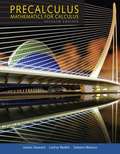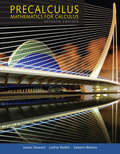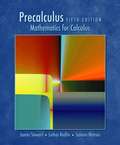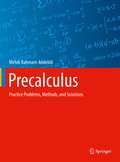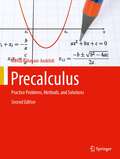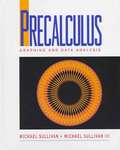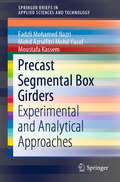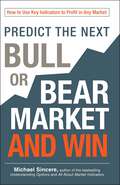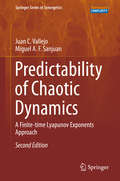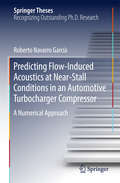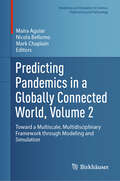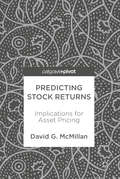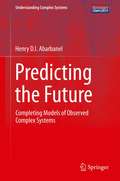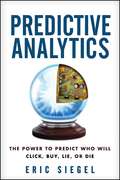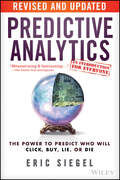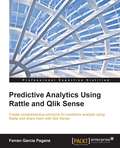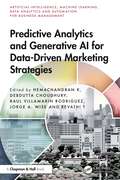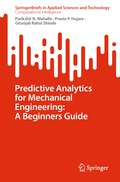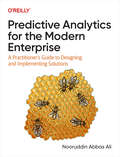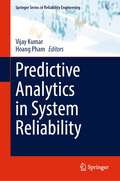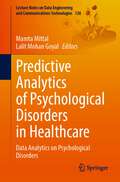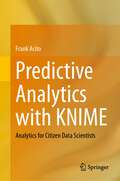- Table View
- List View
Precalculus: Mathematics for Calculus
by James Stewart Lothar Redlin Saleem WatsonThis bestselling author team explains concepts simply and clearly, without glossing over difficult points. Problem solving and mathematical modeling are introduced early and reinforced throughout, providing students with a solid foundation in the principles of mathematical thinking. Comprehensive and evenly paced, the book provides complete coverage of the function concept, and integrates a significant amount of graphing calculator material to help students develop insight into mathematical ideas. The authors' attention to detail and clarity--the same as found in James Stewart's market-leading Calculus text--is what makes this text the proven market leader.
Precalculus: Mathematics for Calculus
by James Stewart Lothar Redlin Saleem WatsonThis bestselling author team explains concepts simply and clearly, without glossing over difficult points. Problem solving and mathematical modeling are introduced early and reinforced throughout, providing students with a solid foundation in the principles of mathematical thinking. Comprehensive and evenly paced, the book provides complete coverage of the function concept, and integrates a significant amount of graphing calculator material to help students develop insight into mathematical ideas. The authors' attention to detail and clarity—the same as found in James Stewart's market-leading Calculus text—is what makes this text the proven market leader.
Precalculus: Mathematics for Calculus (5th Edition)
by James Stewart Lothar Redlin Saleem WatsonThis textbook helps students to use the book as a guide to mastering precalculus mathematics. It provides complete coverage of the function concept and integrates substantial graphing calculator materials and explains concepts simply and clearly, without glossing over difficult points. Problem solving and mathematical modeling are introduced early and reinforced throughout, so that when students finish the course, they have a solid foundation in the principles of mathematical thinking.
Precalculus: Practice Problems, Methods, and Solutions
by Mehdi Rahmani-AndebiliThis study guide is designed for students taking courses in precalculus. The textbook includes practice problems that will help students to review and sharpen their knowledge of the subject and enhance their performance in the classroom. Offering detailed solutions, multiple methods for solving problems, and clear explanations of concepts, this hands-on guide will improve student’s problem-solving skills and basic understanding of the topics covered in their pre-calculus and calculus courses.Exercises cover a wide selection of basic and advanced questions and problems;Categorizes and orders the problems based on difficulty level, hence suitable for both knowledgeable and under-prepared students;Provides detailed and instructor-recommended solutions and methods, along with clear explanations;Can be used along with core precalculus textbooks.
Precalculus: Practice Problems, Methods, and Solutions
by Mehdi Rahmani-AndebiliThe second edition of this study guide is written and designed for students taking a precalculus course. It includes new and expanded exercises with final answers that will help students to review and sharpen their knowledge of the subject and enhance their performance in the classroom. The author uses methods typically found in instructor-recommended textbooks, offering detailed solutions, multiple methods for solving problems, and clear explanations of concepts. This hands-on guide will improve students’ problem-solving skills and foster a solid understanding of calculus, which will benefit them in all of their calculus-based courses.
Precalulus: Graphing And Data Analysis
by Michael SullivanThe goal of this book is to provide a solid mathematical foundation via visualization of real world data. Technology is used as a tool to solve problems, motivate concepts, explore and preview mathematical concepts and to find curves of best fit to the data. Most mathematical concepts are developed and illustrated both algebraically and graphically, with the more intuitive and appropriate method presented first. Also included in this book is a foreshadowing of calculus through the chapter on Limits and Derivatives.
Precast Segmental Box Girders: Experimental and Analytical Approaches (SpringerBriefs in Applied Sciences and Technology)
by Fadzli Mohamed Nazri Mohd Azrulfitri Mohd Yusof Moustafa KassemThis book explores the fundamentals of the elastic behaviour of erected precast segmental box girders (SBG) when subjected to static load, as well as the construction process (casting and erection work) involved. It analyzes and compares the experimental results with those obtained using the finite element method and theoretical calculations. A short-term deflection analysis for different loads is obtained by determining the maximum deflection, stress and strain value of single span precast SBG under a variety of transversal slope. The outcome of this work provides a better understanding of the behaviour of precast SBG in terms of structural responses as well as defects, so that maintenance work can then be focused on the critical section at mid span area specifically for the bridge project longitudinally and transversely. The book is of interest to industry professionals involved in conducting static load tests on bridges, and all researchers, designers, and engineers seeking to validate experimental work with numerical and analytical approaches.
Precious Moments: Countdown to Easter (Precious Moments)
by Precious Moments7, 6, 5—Jesus is alive! Celebrate Easter with this Precious Moments counting book for toddlers and preschoolers. With all the sweet nostalgia and classic illustrations you've loved from Precious Moments since the 1970s, Countdown to Easter is the perfect way to prepare your family for the resurrection day as little ones practice their counting skills, find fun Easter items, and learn about Jesus' greatest gift. Precious Moments: Countdown to Easteris an oversized board book for kids ages 0–4;celebrates the miracles of Easter and the spring season;teaches counting backward from 10 with fun, rhyming text;features vintage-style artwork of children and animals with teardrop eyes; andhighlights the joy Jesus brings.Whether it's an addition to an Easter basket or a gift to kick off the Lent season, this bright and joyful book keeps Jesus at the center. Count your way to the resurrection from 10 sheep to 2 angels and 1 Jesus forever and ever!Since 1978, Precious Moments has grown into a brand recognized worldwide. Its message of God's love shared through books and Bibles published with Thomas Nelson has impacted over 14 million lives.
Predict the Next Bull or Bear Market and Win: How to Use Key Indicators to Profit in Any Market
by Michael SincereThe secrets to making money--no matter what the market conditions!A fundamental guide to investing, Predict the Next Bull or Bear Market and Win shows you how to build your wealth and protect your investments in an ever-changing market. With author and financial expert Michael Sincere's guidance, you'll learn everything you need to know about the key economic indicators that can help you predict the market's performance and better understand when to sell and when to buy.Unlike competing books that attempt a comprehensive survey of all market indicators, Sincere focuses only on those that make a real impact. His clear, concise strategies show you how to prosper during bull markets, be cautious during sideways markets, and make a profit when the market is going down.Predict the Next Bull or Bear Market and Win thoroughly educates you on the small number of indicators that are essential to a growing portfolio in a tumultuous market. By understanding the right economic indicators, you'll learn how to make money in any kind of market!
Predict the Next Bull or Bear Market and Win: How to Use Key Indicators to Profit in Any Market
by Michael SincereThe secrets to making money--no matter what the market conditions!A fundamental guide to investing, Predict the Next Bull or Bear Market and Win shows you how to build your wealth and protect your investments in an ever-changing market. With author and financial expert Michael Sincere's guidance, you'll learn everything you need to know about the key economic indicators that can help you predict the market's performance and better understand when to sell and when to buy.Unlike competing books that attempt a comprehensive survey of all market indicators, Sincere focuses only on those that make a real impact. His clear, concise strategies show you how to prosper during bull markets, be cautious during sideways markets, and make a profit when the market is going down.Predict the Next Bull or Bear Market and Win thoroughly educates you on the small number of indicators that are essential to a growing portfolio in a tumultuous market. By understanding the right economic indicators, you'll learn how to make money in any kind of market!
Predictability of Chaotic Dynamics: A Finite-time Lyapunov Exponents Approach (Springer Series in Synergetics)
by Juan C. Vallejo Miguel A. SanjuanThis book is primarily concerned with the computational aspects of predictability of dynamical systems - in particular those where observations, modeling and computation are strongly interdependent. Unlike with physical systems under control in laboratories, in astronomy it is uncommon to have the possibility of altering the key parameters of the studied objects. Therefore, the numerical simulations offer an essential tool for analysing these systems, and their reliability is of ever-increasing interest and importance. In this interdisciplinary scenario, the underlying physics provide the simulated models, nonlinear dynamics provides their chaoticity and instability properties, and the computer sciences provide the actual numerical implementation. This book introduces and explores precisely this link between the models and their predictability characterization based on concepts derived from the field of nonlinear dynamics, with a focus on the strong sensitivity to initial conditions and the use of Lyapunov exponents to characterize this sensitivity. This method is illustrated using several well-known continuous dynamical systems, such as the Contopoulos, Hénon-Heiles and Rössler systems. This second edition revises and significantly enlarges the material of the first edition by providing new entry points for discussing new predictability issues on a variety of areas such as machine decision-making, partial differential equations or the analysis of attractors and basins. Finally, the parts of the book devoted to the application of these ideas to astronomy have been greatly enlarged, by first presenting some basics aspects of predictability in astronomy and then by expanding these ideas to a detailed analysis of a galactic potential.
Predicting Flow-Induced Acoustics at Near-Stall Conditions in an Automotive Turbocharger Compressor
by Roberto Navarro GarcíaThis thesis offers new insights into the fluid flow behavior of automotive centrifugal compressors operating under near-stall conditions. Firstly it discusses the validation of three-dimensional computational fluid dynamics (CFD) unsteady simulations against acoustic experimental measurements using an original procedure based on plane wave pressure decomposition. It then examines the configuration of the CFD cases, highlighting the key parameters needed for a successful calculation. Moreover, it describes both the compressor mean and unsteady flow field from best-efficiency to near-surge operating points. Lastly, it provides readers with explanations of the various phenomena that arise when the mass flow rate is reduced and the compressor is driven to poor and noisy performance. Written for students, researchers and professionals who want to improve their understanding of the complex fluid flow behavior in centrifugal compressors, the thesis offers valuable practical insights into reducing the acoustic emissions of turbochargers.
Predicting Pandemics in a Globally Connected World, Volume 1: Toward a Multiscale, Multidisciplinary Framework through Modeling and Simulation (Modeling and Simulation in Science, Engineering and Technology)
by Nicola Bellomo Mark A. J. ChaplainThis contributed volume investigates several mathematical techniques for the modeling and simulation of viral pandemics, with a special focus on COVID-19. Modeling a pandemic requires an interdisciplinary approach with other fields such as epidemiology, virology, immunology, and biology in general. Spatial dynamics and interactions are also important features to be considered, and a multiscale framework is needed at the level of individuals and the level of virus particles and the immune system. Chapters in this volume address these items, as well as offer perspectives for the future.
Predicting Pandemics in a Globally Connected World, Volume 2: Toward a Multiscale, Multidisciplinary Framework through Modeling and Simulation (Modeling and Simulation in Science, Engineering and Technology)
by Nicola Bellomo Mark Chaplain Maíra AguiarIn an increasingly globally-connected world, the ability to predict, monitor, and contain pandemics is essential to ensure the health and well-being of all. This contributed volume investigates several mathematical techniques for the modeling and simulation of viral pandemics, with a special focus on COVID-19. Modeling a pandemic requires an interdisciplinary approach with other fields such as epidemiology, virology, immunology, and biology in general. Spatial dynamics and interactions are also important features to be considered, and a multiscale framework is needed at the societal level, the level of individuals, and the level of virus particles and the immune system. Chapters in this volume explore the latest research related to these items to demonstrate the utility of a variety of mathematical methods. Perspectives for the future are also offered
Predicting Stock Returns
by David G McMillanThis book provides a comprehensive analysis of asset price movement. It examines different aspects of stock return predictability, the interaction between stock return and dividend growth predictability, the relationship between stocks and bonds, and the resulting implications for asset price movement. By contributing to our understanding of the factors that cause price movement, this book will be of benefit to researchers, practitioners and policy makers alike.
Predicting the Future
by Henry AbarbanelThrough the development of an exact path integral for use in transferring information from observations to a model of the observed system, the author provides a general framework for the discussion of model building and evaluation across disciplines. Through many illustrative examples drawn from models in neuroscience, geosciences, and nonlinear electrical circuits, the concepts are exemplified in detail. Practical numerical methods for approximate evaluations of the path integral are explored, and their use in designing experiments and determining a model's consistency with observations is explored.
Predictive Analytics
by Thomas H. Davenport Eric Siegel"The Freakonomics of big data."--Stein Kretsinger, founding executive of Advertising.com; former lead analyst at Capital OneThis book is easily understood by all readers. Rather than a "how to" for hands-on techies, the book entices lay-readers and experts alike by covering new case studies and the latest state-of-the-art techniques.You have been predicted -- by companies, governments, law enforcement, hospitals, and universities. Their computers say, "I knew you were going to do that!" These institutions are seizing upon the power to predict whether you're going to click, buy, lie, or die.Why? For good reason: predicting human behavior combats financial risk, fortifies healthcare, conquers spam, toughens crime fighting, and boosts sales.How? Prediction is powered by the world's most potent, booming unnatural resource: data. Accumulated in large part as the by-product of routine tasks, data is the unsalted, flavorless residue deposited en masse as organizations churn away. Surprise! This heap of refuse is a gold mine. Big data embodies an extraordinary wealth of experience from which to learn.Predictive analytics unleashes the power of data. With this technology, the computer literally learns from data how to predict the future behavior of individuals. Perfect prediction is not possible, but putting odds on the future -- lifting a bit of the fog off our hazy view of tomorrow -- means pay dirt.In this rich, entertaining primer, former Columbia University professor and Predictive Analytics World founder Eric Siegel reveals the power and perils of prediction:What type of mortgage risk Chase Bank predicted before the recession.Predicting which people will drop out of school, cancel a subscription, or get divorced before they are even aware of it themselves.Why early retirement decreases life expectancy and vegetarians miss fewer flights.Five reasons why organizations predict death, including one health insurance company.How U.S. Bank, European wireless carrier Telenor, and Obama's 2012 campaign calculated the way to most strongly influence each individual.How IBM's Watson computer used predictive modeling to answer questions and beat the human champs on TV's Jeopardy!How companies ascertain untold, private truths -- how Target figures out you're pregnant and Hewlett-Packard deduces you're about to quit your job.How judges and parole boards rely on crime-predicting computers to decide who stays in prison and who goes free.What's predicted by the BBC, Citibank, ConEd, Facebook, Ford, Google, IBM, the IRS, Match.com, MTV, Netflix, Pandora, PayPal, Pfizer, and Wikipedia. A truly omnipresent science, predictive analytics affects everyone, every day. Although largely unseen, it drives millions of decisions, determining whom to call, mail, investigate, incarcerate, set up on a date, or medicate.Predictive analytics transcends human perception. This book's final chapter answers the riddle: What often happens to you that cannot be witnessed, and that you can't even be sure has happened afterward -- but that can be predicted in advance?Whether you are a consumer of it -- or consumed by it -- get a handle on the power of Predictive Analytics.
Predictive Analytics
by Eric Siegel"Mesmerizing & fascinating..." --The Seattle Post-Intelligencer "The Freakonomics of big data." --Stein Kretsinger, founding executive of Advertising.com Award-winning | Used by over 30 universities | Translated into 9 languages An introduction for everyone. In this rich, fascinating -- surprisingly accessible -- introduction, leading expert Eric Siegel reveals how predictive analytics works, and how it affects everyone every day. Rather than a "how to" for hands-on techies, the book serves lay readers and experts alike by covering new case studies and the latest state-of-the-art techniques. Prediction is booming. It reinvents industries and runs the world. Companies, governments, law enforcement, hospitals, and universities are seizing upon the power. These institutions predict whether you're going to click, buy, lie, or die. Why? For good reason: predicting human behavior combats risk, boosts sales, fortifies healthcare, streamlines manufacturing, conquers spam, optimizes social networks, toughens crime fighting, and wins elections. How? Prediction is powered by the world's most potent, flourishing unnatural resource: data. Accumulated in large part as the by-product of routine tasks, data is the unsalted, flavorless residue deposited en masse as organizations churn away. Surprise! This heap of refuse is a gold mine. Big data embodies an extraordinary wealth of experience from which to learn. Predictive Analytics unleashes the power of data. With this technology, the computer literally learns from data how to predict the future behavior of individuals. Perfect prediction is not possible, but putting odds on the future drives millions of decisions more effectively, determining whom to call, mail, investigate, incarcerate, set up on a date, or medicate. In this lucid, captivating introduction -- now in its Revised and Updated edition -- former Columbia University professor and Predictive Analytics World founder Eric Siegel reveals the power and perils of prediction: What type of mortgage risk Chase Bank predicted before the recession. Predicting which people will drop out of school, cancel a subscription, or get divorced before they even know it themselves. Why early retirement predicts a shorter life expectancy and vegetarians miss fewer flights. Five reasons why organizations predict death -- including one health insurance company. How U.S. Bank and Obama for America calculated -- and Hillary for America 2016 plans to calculate -- the way to most strongly persuade each individual. Why the NSA wants all your data: machine learning supercomputers to fight terrorism. How IBM's Watson computer used predictive modeling to answer questions and beat the human champs on TV's Jeopardy! How companies ascertain untold, private truths -- how Target figures out you're pregnant and Hewlett-Packard deduces you're about to quit your job. How judges and parole boards rely on crime-predicting computers to decide how long convicts remain in prison. 182 examples from Airbnb, the BBC, Citibank, ConEd, Facebook, Ford, Google, the IRS, LinkedIn, Match.com, MTV, Netflix, PayPal, Pfizer, Spotify, Uber, UPS, Wikipedia, and more. How does predictive analytics work? This jam-packed book satisfies by demystifying the intriguing science under the hood. For future hands-on practitioners pursuing a career in the field, it sets a strong foundation, delivers the prerequisite knowledge, and whets your appetite for more. A truly omnipresent science, predictive analytics constantly affects our daily lives. Whether you
Predictive Analytics Using Rattle and Qlik Sense
by Ferran Garcia PagansIf you are a business analyst who wants to understand how to improve your data analysis and how to apply predictive analytics, then this book is ideal for you. This book assumes you have some basic knowledge of statistics and a spreadsheet editor such as Excel, but knowledge of QlikView is not required.
Predictive Analytics and Generative AI for Data-Driven Marketing Strategies (Artificial Intelligence, Machine Learning, Data Analytics and Automation for Business Management)
by Hemachandran K Raul Villamarin Rodriguez Debdutta Choudhury Jorge A. Wise Revathi TIn providing an in-depth exploration of cutting-edge technologies and how they are used to support data-driven marketing strategies and empower organizations to make the right decisions, Predictive Analytics and Generative AI for Data-Driven Marketing Strategies includes real-world case studies and examples from diverse marketing domains. This book demonstrates how predictive analytics and generative AI have been successfully applied to solve marketing challenges and drive tangible results. This book showcases emerging trends in predictive analytics and generative AI for marketing, and their potential impact on the future of data-driven marketing. This book is meant for professionals and scholars to gather the skills and resources to use predictive analytics and generative AI effectively for marketing strategies.This book: • Examines the different predictive analytics models and algorithms, such as regression analysis, decision trees, and neural networks, and demonstrates how they may be utilized to get insightful conclusions from marketing data.• Includes generative AI techniques, such as generative adversarial networks (GANs) and variational autoencoders (VAEs), showcasing how these techniques can generate synthetic data for marketing insights and decision-making.• Highlights the importance of data-driven marketing choices and illustrates how generative AI and predictive analytics may be quite useful in this context.• Integrates the principles of data science with marketing concepts, offering a cohesive understanding of how predictive analytics and generative AI can power data-driven marketing decisions.• Presents the recent advances in predictive analytics and generative AI and discusses how they can affect the area of data-driven marketing.
Predictive Analytics for Mechanical Engineering: A Beginners Guide (SpringerBriefs in Applied Sciences and Technology)
by Parikshit N. Mahalle Gitanjali Rahul Shinde Pravin P. HujareThis book focus on key component required for building predictive maintenance model. The current trend of Maintenance 4.0 leans towards the preventive mechanism enabled by predictive approach and condition-based smart maintenance. The intelligent decision support, earlier detection of spare part failure, fatigue detection is the main slices of intelligent and predictive maintenance system (PMS) leading towards Maintenance 4.0 This book presents prominent use cases of mechanical engineering using PMS along with the benefits. Basic understanding of data preparation is required for development of any AI application; in view of this, the types of the data and data preparation processes, and tools are also presented in this book.
Predictive Analytics for the Modern Enterprise: A Practitioner's Guide To Designing And Implementing Solutions
by Nooruddin Abbas AliThe surging predictive analytics market is expected to grow from $10.5 billion today to $28 billion by 2026. With the rise in automation across industries, the increase in data-driven decision-making, and the proliferation of IoT devices, predictive analytics has become an operational necessity in today's forward-thinking companies.If you're a data professional, you need to be aligned with your company's business activities more than ever before. This practical book provides the background, tools, and best practices necessary to help you design, implement, and operationalize predictive analytics on-premises or in the cloud. Explore ways that predictive analytics can provide direct input back to your businessUnderstand mathematical tools commonly used in predictive analyticsLearn the development frameworks used in predictive analytics applicationsAppreciate the role of predictive analytics in the machine learning processExamine industry implementations of predictive analyticsBuild, train, and retrain predictive models using Python and TensorFlow
Predictive Analytics in System Reliability (Springer Series in Reliability Engineering)
by Hoang Pham Vijay KumarThis book provides engineers and researchers knowledge to help them in system reliability analysis using machine learning, artificial intelligence, big data, genetic algorithm, information theory, multi-criteria decision making, and other techniques. It will also be useful to students learning reliability engineering.The book brings readers up to date with how system reliability relates to the latest techniques of AI, big data, genetic algorithm, information theory, and multi-criteria decision making and points toward future developments in the subject.
Predictive Analytics of Psychological Disorders in Healthcare: Data Analytics on Psychological Disorders (Lecture Notes on Data Engineering and Communications Technologies #128)
by Mamta Mittal Lalit Mohan GoyalThis book discusses an interdisciplinary field which combines two major domains: healthcare and data analytics. It presents research studies by experts helping to fight discontent, distress, anxiety and unrealized potential by using mathematical models, machine learning, artificial intelligence, etc. and take preventive measures beforehand. Psychological disorders and biological abnormalities are significantly related with the applications of cognitive illnesses which has increased significantly in contemporary years and needs rapid investigation. The research content of this book is helpful for psychological undergraduates, health workers and their trainees, therapists, medical psychologists, and nurses.
Predictive Analytics with KNIME: Analytics for Citizen Data Scientists
by Frank AcitoThis book is about data analytics, including problem definition, data preparation, and data analysis. A variety of techniques (e.g., regression, logistic regression, cluster analysis, neural nets, decision trees, and others) are covered with conceptual background as well as demonstrations of KNIME using each tool. The book uses KNIME, which is a comprehensive, open-source software tool for analytics that does not require coding but instead uses an intuitive drag-and-drop workflow to create a network of connected nodes on an interactive canvas. KNIME workflows provide graphic representations of each step taken in analyses, making the analyses self-documenting. The graphical documentation makes it easy to reproduce analyses, as well as to communicate methods and results to others. Integration with R is also available in KNIME, and several examples using R nodes in a KNIME workflow are demonstrated for special functions and tools not explicitly included in KNIME.
